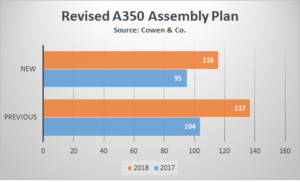Leeham News and Analysis
There's more to real news than a news release.
Fewer A350s in 2017-18, says Cowen & Co.; not so, says Airbus
April 21, 2016: Airbus will assemble fewer A350s than planned in 2017 and 2018, according to a short note to clients by the Cowen &  Co. obtained by LNC.
Co. obtained by LNC.
Not so, says Airbus.
The investment bank was commenting on supplier Hexcel.
Recent Checks Suggest Slower A350 Ramp – Our latest checks indicate that Airbus (as of March 2016) targets 95 and 116 A350 “station 50” assemblies in C17-18E, respectively, vs. the earlier plan (circa November 2015) to reach 104 and 137 assemblies in C17-18E. (For context, “station 50” is where the aircraft wings are adjoined to the body of the plane.) In C16E, the A350 “station 50” target hasn’t changed much (now 70 vs. the prior plan of 69). For context, HXL generates $5MM of sales per A350. Given lead times, this suggests potential for a 2% sales reduction to consensus C17 estimates, and as much as 3-4% to C18E Street estimates. The A320 and A400M Airbus programs had minimal schedule changes in the schedule update, while A380 (3 fewer in C17) and A330 (13 more in C17) targets were tweaked.
The figures are 9% and 15% lower in the two years. However, the higher numbers appear to be more ambitious than Airbus has publicly set previously as its target production rates. Airbus said its goal for production is 10/mo by 2018, although the production capacity is 13/mo.
“Nothing has changed for us,” says an Airbus spokesman. “As we have said on the record, we plan to deliver at least 50 A350 aircraft in 2016 and will then gradually ramp up to rate 10 by the end of 2018.”
| Annual | Previous | New | Difference |
| 2017 | 104 | 95 | 9% |
| 2018 | 137 | 116 | 15% |
| Inferred Monthly Production Rate | |||
| 2017 | 8.67 | 7.92 | |
| 2018 | 11.42 | 9.67 |
The data appears to give some look into how Airbus wanted to more aggressively ramp up production of the A350 than previously indicated. Sales of the A350 have been negatively impacted by the absence of production slots (a similar problem for Boeing at times). Boeing is ramping up production of the 787 to 12/mo this year and 14/mo before the end of the decade (we believe it will be in 2018). The A350, which truly competes with the Boeing 777 and not the 787, nonetheless lags the Boeing wide-body production plans, which do dip as 747-8 production declines to 6/yr from September and 777 Classic production to 7/mo from 2018.
The Cowen notes there will be three fewer A380s next year (no surprise) but 13 more A330ceos, the airplane that competes with the 787.
An Airbus spokesman said the Cowen numbers “(while I’m not confirming them) look absolutely consistent with the rates we already have announced.”
Boeing announced revised 747-8 and 777 production rates in January, lowering each. Airbus said it will increase the rate of the A330ceo from 6/mo to 7/mo. These slightly revise LNC’s production rate forecast through 2020. Rates for the A320 and 737 remain as previously forecast.
Airbus and Boeing now will produce about the same number of wide-bodies going forward. Rates on the single-aisles will seesaw back and forth slightly, with different effective dates for rate hikes. Deliveries are another matter. Boeing is still burning off stored 787s (the Terrible Teens), which will pump deliveries this year. 737 delivers will be down slightly this year as the transition to the MAX takes effect, but the production of these airplanes this year will see a boost in deliveries next year.
Airbus deliveries of the A320neo and A350 are negatively affected by supplier challenges. Airplanes are piling up in Toulouse and Hamburg, but should catch up by year-end. The A330neo is planned to enter service in December 2017; we think it likely these few slip into 1Q2018, based on history.
Airbus’ first quarter earnings call is April 28.




Can’t work out whether this is a story or a nonstory. I am confused (perpetually) re the targets set out by Airbus and those at station 50. Does this mean Airbus are simply looking to stabilise production at 10/month prior to pushing to13/month or is it more serious than that?
IMU the Cohen announcement is about a reduction to “as planned”. i.e. they announce the frustration of a tentative increase as a decrease.
Strange, that and maybe someone else urgently needs some “countervailing press” 😕 ( Hint Boeing is to store early MAX frames beyond delivery of later production. similar to the 787?)
this is news for investors only as it is talking about earnings targets based on market intel. Airbus had publicly targeted a lower number, while telling their suppliers that they were shooting for a higher number, no it looks like they are going to hit somewhere in the middle.
This is only news if you are gambling in the great casino they call the stock market.
this is equivalent to bookies in Vegas changing the odds on the Patriots game based on rumors that Edelmen dropped 3 passes from Tom Brady in practice on Wednesday.
What does any of this have to do with MAX storing plans? This is a story about the A350 and a production slide and how a market update from one of the A350 suppliers is dealing with a “yet to be announced” production rate cut. Stay on message please.
A bit naive.
It is a pretty regular feature that emerging problems at Boeing are framed by dire predictions relating to Airbus.
I haven’t seen any evidence of that on this website.
Obviously.
Leeham is a commentary site and not a PR agency.
( and the “reduced production” insertion has been published by other sources anyway )
It is my observation that negative upcoming news relating to Boeing oftentimes have “forerunners” blowing up some rather minor thing from the competitors.( mostly Airbus but not limited to A. ) On other occasions faked sales information was released to uplift the stock value.
absolutely not. I have been watching how the production ramp-up of the A350 has been very slow. I can’t imagine it is just a problem with France-based Zodiac. This Dutch website is wonderful-http://www.abcdlist.nl/a350f/a350f.html. It appears they delivered the 20th a350 yesterday to Singapore Airlines. That is the 20th total
and only the 5th this year! It is nearly May, approaching mid-year and they have only delivered 1/10 of their target?
This grassy knoll stuff is getting tired
Totally agree Enzo
I am waiting for Uwe to opine on whether or not:
1) the moon landings were fake
2) tupac shakur is still alive
3) the KGB perfected mind control and used it on Jimmy Carter
Wait on.
I presented an observation and not an opinion.
It seems that both Boeing and Airbus have had,are having very serious problems
with suppliers to the extent it affects other suppliers down the line. One example is Rolls Royce who were geared for a proper ramp up this year and are now finding they having to slow down production of the A350 engines. Most notable
is Zodiac for their complete and utter failure to supply interiors. Pushing Boeing into the position of setting up its own interiors manufacturing company called Lift. It looks like Airbus too are removing Zodiac from future projects to try and get back some control to delivery. Its seems its all or nothing.
I’m waiting for the first brave analyst to observe the forecasted 737 production rates until 2020-21 might not be realistic.
Based on recent sales, potential buyers, undecided “buyers” in the MAX backlog and the competitive situation as stated by Conner.
As Scott’s recent article (B lost NB battle) showed, its an open nerve folks are hesitant to address. It just doesn’t make life easier.
https://adarvetranslationsblog.files.wordpress.com/2014/03/shoot-the-messenger.gif
Happy to address. Spot on topic. It could be most interesting and agreed its one to keep a close eye on.
Keesje:
I see 645 unidentified MAX on Boeing site, how many on Airbus?
What about 20% of the total for Boeing?
Man I wish people would stick with the issue Scott presented and not try to throw Boeing under the bus. By the way there is another story about Boeing that will have a major impact on the narrow body world. Boeing is shopping a smaller 737 replacement that will eliminate the -7 MAX. If UA and SWA bite Boeing will pull the trigger on a new narrow body to address the CS300 threat. Now if they do that your theory of the MAX issues will then be not worth discussing because the A319NEO will need to do something also. But this is a story about the A350, so please stick with topic.
Considering how many here scoffed at them making the 2017 target date I wo7ld not bet against them.
One big mistake: station 50 is fuselage join. Wign to body join is done at station 40. It has to show the quality of the analysis done by said bank.
Was assuming they use station 50 as the first step in FAL but stand to be corrected
Ho hum, we hoped to hit 100, we are only going to hit 80, so it goes.
Boeing biggest 737 customer can not find extra slot in 2020-2021. With 4400 plus a/c you do the math Keesje.
I think we take that with a grain of salt.
I concur with Keeje, its one to keep a close eye on.
So far for 737 there seems to be a lot of ability to adjust and get slots as needed.
There are a significant number of non attributed 737s
Its an interesting aspect and with the A3210 moving to 50% of the production and Boeing not able to match where does a 737 customer that needs that kind of capability go?
To the next 737 replacement. I assume Boeing has come to the conclusion that the 737-7 and the -9 are DOA? Something needs to be done, the -8 MAX will be fine for a few years but the other ends are showing signs of REAL weakness. Gather the first move is to knock back the smaller player first and then use a larger version for the 757 replacement? Guess selling low ball 737s was not a worthwhile long term winning strategy? Based on what Oman said about the A330NEO, Airbus might find their strategy of selling warmed over frames not being well received? But then Oman and others should use the commenters on this site as their advisors? And, Scott to because the warmed over NEOs are going to kill the too tight 787s.
“Airbus might find their strategy of selling warmed over frames not being well received?”
Aside from procurement problems etc. facing both Airbus and Boeing, I wonder whether the Trent 1000 TEN could compound matters for Airbus. It’s now focussing more on additional efficient trust to feed the 787-10 as well as 787-9/10 and its a much larger order book than the Trent 7000’s for the A330 Neo. I hope they can do a good job on the 7000. It would be a diservice to sully the A330 line ehich has such great rep.
Airbus will only catch up with Boeing in twin aisle deliveries when the A350 closes within two per month behind the 787, probably no sooner than 2020.
So now Scott what should Airbus do? Appears their production of widebodies will now be equal or less than Boeing? This was not what you have been forecasting? You’ve said that Airbus would overtake Boeing and now the A350, with all of its wonderful rollout strategies has fallen upon a different rollout glitch. Simply put, Boeing went out and bought up all the capacity everywhere to support the 787 ramp ups. And, what Boeing bought was not even enough for its own production requirements. What happened to your models that would have shown this, Mr Aviation Master reader of the tea leaves? Didn’t I ask you to look at suppliers a long time ago when you started this? Was I not trying to tell you that you needed to follow the supplier train? There simply is not enough room in the world to build all of these widebodies and narrow body frames. This industry 10 years ago produced 400 aircraft annually, and now we see that in a month? Something had to give, first the seats, then the lavs, then the engines. And it’s not just the finished goods that are busting at the seams, its the raw materials required to support these special material requirements that will continue be challenged. Airbus will not be able to build the A350/A330CEO/NEO/A380s at ~20 per month, while Boeing is building 747/767/777/787 at ~20 per month. Not enough industry capacity to cover that and address the narrow body ramp ups at both companies and those other two guys ramping up also. This day was coming. So what is next with your models Mr Avaition Tea Leaf reader? By the way how many frames are sitting around in France and Germany waiting for parts. But wait, they are all sitting around because Boeing did something to Pratt engines right? I know that blue logo company had something to do with causing those problems. Nope, the world is not big enough to support the dreams of aviation. Just move more to China they can do everything.
@Vincent: Setting aside your rather snotty approach to this, if you look at the line chart carefully, you will see there is a short period in which Airbus will out-produce Boeing in 2019. This is based on declining production rates for the 777 Classic and before the ramp up of the 777X gears up; the expectation that the 747-8 program is terminated; a downward projection for the A380 (steeper than Reuter’s story of 1.7/mo today); and adjusting rates up for the A320 and 737 lines.
Note that production and deliveries aren’t always the same number–as the post says. You were talking about deliveries when you “asked” me to take a look at this. I have.
The engine issues were well covered by other media and we had nothing to add to that. The deliveries are delayed.
If you have the power of recall, you will know that I follow the supply chain and obtain a fair amount of information from there. I’m not sure someone who works for the Wisconsin Department of Workforce Development Apprenticeship program is better positioned in the supply chain than I am.
It seems Boeing is proposing a 737-7.5 to a just right 150 fit to Delta and Southwest.
http://www.wsj.com/articles/boeing-considering-new-737-model-to-fend-off-bombardier-jet-1461259670
Someone here suggested that a few months ago while discussing an A320.5. It struck me as not such a crazy idea either then already.
Make that 14 months 😐 TC. 10th – 11th reply.
https://leehamnews.com/2015/02/25/787-3-737-10-no-replacement-for-757/
Would American buy it? I’m surprised they don’t ditch the MAX, switch to an all Airbus A320neo /A321neo future.
As for Southwest, about 36m length would seem about optimal.
For United this might not fit 150, but with first class, can 3 flight attendants cover that many people anyway, so about 140 is a good fit.
Alaska, Icelandair, Westjet, and a few others are all likely orders.
Possibly, in the next 10 years, most airlines would standardize on a selection of one type,
737-7x 36m
737-8 39.5m
737-9 42m
A320 37.5m
A320x 41m
A321 44.5m
Or a CS300/CS500 with the A320x/A321 for someone like Delta.
I think an optimized A320.5 for 200 passengers single class, with decent pitch galleys and lavatories, is the NB joker Airbus keeps under the table.
The A321 is an excellent airframe but way bigger, heavier and more expensive than a A320, 7 meters/ rows.
While the A320 is a rightsized for 150 seats, with the news that JetBlue will switch to 162, that rationale is gone for them. We’ll see if they take any A320neos, or just wait for the A320.5.
Es lastimoso que tanto Airbus como Boeing, no salgan a afrontar públicamente sus verdaderas inconsistencias en su lineas de producción.
Personalmente pienso que los que estamos apasionados por los temas tecnología, productividad, eficiencia; desconocemos grandemente lo que pasa y va pasar en los temas de ejecución de estas Empresas.
Por ahora es importante que estos dos fabricantes se concentren en ser honesto y fabriquen buenos aviones (seguros, rentables y ecosostenibles.
Google translation:
It is a pity that both Airbus and Boeing do not come out publicly facing their true inconsistencies in their production lines.
Personally I think of those who are passionate about technology, productivity, efficiency; We do not know much about what happens and will happen in the execution issues of these Companies.
For now it is important that these two manufacturers focus on being honest and make good aircraft (safe, profitable and eco-sustainable.